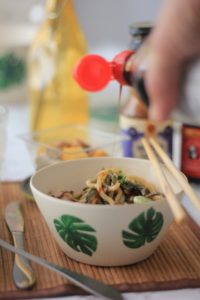 By: Allyson N. Hamilton
By: Allyson N. Hamilton
Oyster Sauce, adding flavor to all your favorites
Have you ever found yourself in a Chinese restaurant, perhaps late at night, staring at a wall covered in elegant Chinese characters with vague and sometimes comical English descriptions of each dish? (I’ll never forget that my favorite dish in undergrad was called “surprised chicken,” but was a dish very similar to traditional Szechuan-style chicken). As you look through the dozens of offerings, you are also watching the line of people before you place their order by either giving a number, or by speaking Chinese and then having what to be excited and pleasant conversations with the cashier. Of course, this adds to the ambiance of the woks clanging against the stove, the baskets of food sizzling in the deep fryer, and the sound of chopsticks being broken apart by patrons at nearby tables. You smell the gentle and nutty aroma of the rice every time the rice cooker is opened to add heaping scoops of rice to a to-go box. This scent mingles with the acidic bouquet of the oil, and the air has a certain spiciness from the chilies that you feel when you take in especially deep breaths. As you stare at the wall you inevitably decide to order something you aren’t sure about, but the description is vague enough to be an adventure…”noodles with brown sauce.”
You are served a fragrant dish of Lo mein (traditional Chinese: 撈麵/撈麪; simplified Chinese: 捞面; pinyin: lāo miàn) or “tossed noodles.” Among the rich dark brown sauce are half-moons of onion, celery pieces cut on the bias, and small matchsticks of carrot. You eat heartily with plenty of leftovers to take home. As you are reheating your leftovers the next day for lunch, you can’t help but wonder…”What is brown sauce?”
Brown sauce is some variety of broth (often beef), combined with a healthy dose of oyster sauce (for flavor and umami), sugar (for sweetness), soy sauce (for color and salt), and cornstarch (for texture and viscosity) [1]. Frequently, chilies, garlic, and ginger are added as aromatics. Most of these ingredients are extremely common, and found in almost every Western kitchen: broth, sugar, cornstarch, and even soy sauce, these days. For more information on soy sauce see “The Story of Science and Soy Sauce” (https://sciencemeetsfood.org/story-science-soy-sauce/). The one ingredient that likely stands out in this recipe is oyster sauce.
Oyster sauce is said to have been invented in 1888 by Lee Kam Sheung, in Nam Shui Village in Guangdong Province, China [2]. It is said that the sauce, like many other revolutionary foods, was made on accident when he overcooked some bivalves [3]. His company, Lee Kum Kee, continues to produce oyster sauce today and is worth over $15B [3]. While originally oyster sauce was made only from cooked oysters, manufacturers now add thickening agents like cornstarch, sweeteners like high fructose corn syrup, and umami boosters like MSG [4]. Moreover, now vegetarian options are available and are typically made from mushrooms of either shiitake (Lentinula edodes) or oyster (Pleurotus ostreatus) varieties. There are also varieties made without added MSG, even though this is completely unnecessary. Xenophobia led to wide-spread misinformation about MSG and went so far as to convince actual physicians that a condition called “Chinese Restaurant Syndrome” was real. The science is clear about MSG (it adds umami and doesn’t cause adverse health effects), but consumers still demand products without it [5].
Oyster sauce is, as the name implies, is a sauce traditionally made from oysters. (There are vegetarian versions made from mushrooms, as well) To make your own is incredibly simple: all you need are oysters, salt, and soy sauce. Shuck and finely chop the oysters (saving the liquid or liquor). Add everything to a pan and simmer ~10 minutes. Add 2 tsp salt per pound of shucked oysters (and liquor). Remove the solids with a sieve and discard. Add 2 TB of soy sauce per ½ cup of liquid. Add back to the pan and reduce for about 10 minutes once gently simmering. Add a slurry of cornstarch to thicken, if desired (optional). Store in a clean container for ~1 month. [6].
[1] Wan, L. Chinese brown sauce recipe. The Spruce Eats. Retrieved August 20, 2022, from https://www.thespruceeats.com/chinese-brown-sauce-4065294
[2] Oyster sauce — Asian sauces. Science of Cooking. Retrieved August 20, 2022, from https://www.scienceofcooking.com/food-encyclopedia/oyster_sauce.htm
[3] Schmidt, B. (2019, August 29). A $15 billion oyster sauce family plots to survive 1,000 years. Bloomberg.com. Retrieved August 20, 2022, from https://www.bloomberg.com/news/articles/2019-08-29/a-15-billion-oyster-sauce-family-plots-to-survive-1-000-years#:~:text=Lee%20Kum%20Sheung%20invented%20oyster,a%20staple%20of%20Cantonese%20cuisine.
[4] Wikimedia Foundation. Oyster sauce. Wikipedia. Retrieved August 20, 2022, from https://en.wikipedia.org/wiki/Oyster_sauce#cite_note-5
[5] Barry-Jester, A. M. How MSG got a bad rap: Flawed science and xenophobia. FiveThirtyEight. Retrieved August 20, 2022, from https://fivethirtyeight.com/features/how-msg-got-a-bad-rap-flawed-science-and-xenophobia/
[6] Zhangbo, H. Homemade oyster sauce. RecipeLand.com. Retrieved August 20, 2022, from https://recipeland.com/recipe/v/homemade-oyster-sauce-52990
[7] Featured Image by Carlos Lopez via Pexels
___________________________________________________________

Allyson N. Hamilton | LinkedIn
SMF Blog Writer
Allyson received her B.S. in Chemistry at Indiana University Bloomington. She is currently pursuing her PhD in Food safety at the University of Arkansas. Allyson also works as an English as a second language tutor for Chinese students and enjoys reading and writing about all things FOOD in her spare time.






Leave a Reply